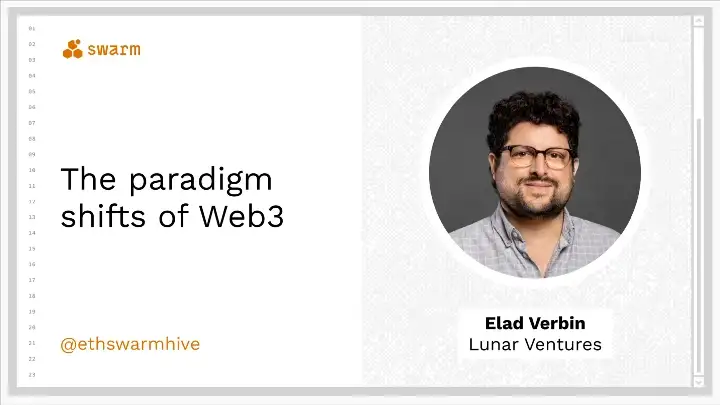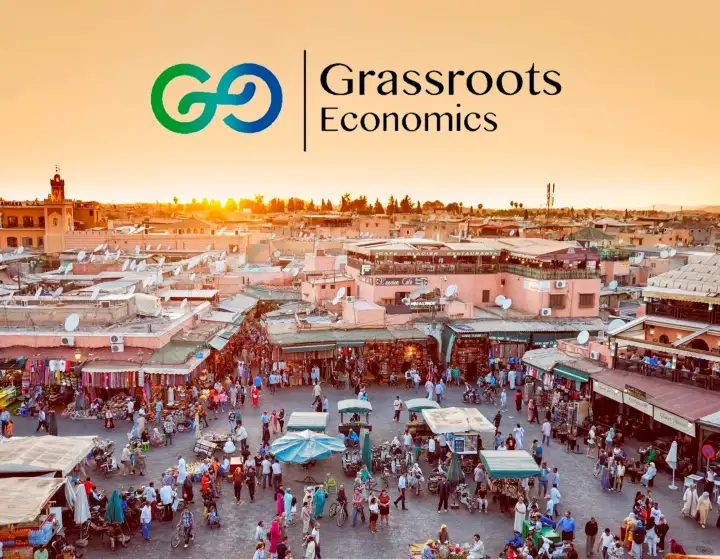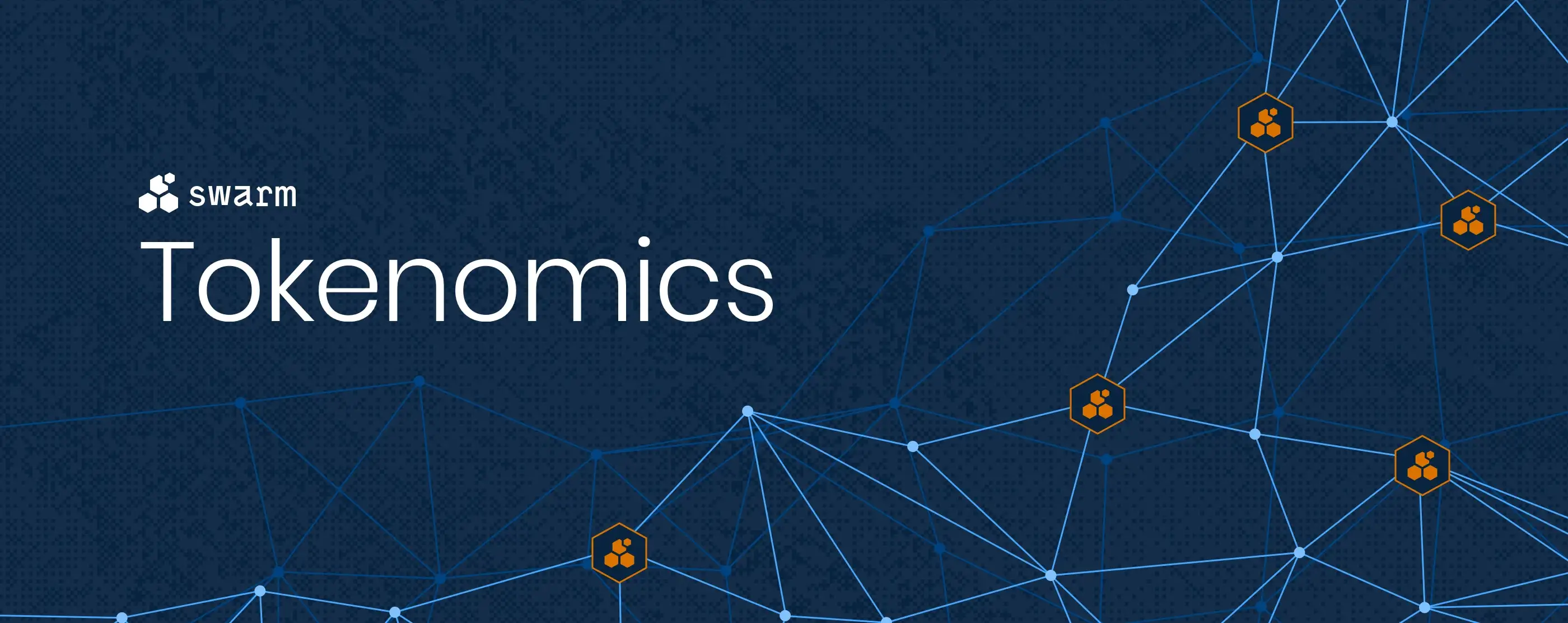“The most powerful force is social collaboration and Swarm will empower thousands of developers to create a rich ecosystem to supercharge our lives.”
TL;DR:
- In 2024 Swarm will be a fully decentralised world database, an unstoppable machine powered by microtransactions.
- The key economic insight is that hosting will be supported by users, enabling open innovation, interoperability and lowering the barriers for colonies.
- Developers will not need a profit model in advance; this will completely change how they work, how they make money, and what the end users will get.
- It will also give engineers much more powerful tools to work with than what centralised solutions offer right now.
- To build a project on Swarm, plan for what features Swarm will provide in three years’ time, not what it offers today.
In the first part of his talk, Elad Verbin took a look at how to build a startup on Swarm. As he admits, building a startup in today’s complex world takes time: there are mistakes and numerous iterations. “Before you’re finished the world has moved on. So you need to look at how the world will look three years from now,” he adds.
This holds true when building a project on Swarm, as well. **The world and Swarm are both constantly changing. _“So you need to look at both and think about how they will look in three years’ time.” _**But this is not an easy task because you can’t know for sure what emergent behaviour a technology, once it reaches critical mass, will spur.
Take smartphones for example. Elad’s thought experiment goes like this. It’s 2007 and the iPhone has just come out. At this time, it is nothing more than a flip phone that can run programs. Now, we need to think about what it will look like in 2010. What the iPhone really means, in Elad’s words, is that there will be a computer in everyone’s pocket that is always connected to the internet, equipped with a GPS, camera and a sensor array.
“You don’t build an alarm clock. You build Instagram, you build Twitter, you build something that takes advantage of all these new things,” Elad reminds us.
Feature-packed future
How about Swarm, then? Well, in 2021 it’s not much beyond a chunk store with some additional features. So, what will it look like in 2024? A whole lot different. It will become a world database, that anyone can access from anywhere, and a generally unstoppable machine powered by microtransactions; fully decentralised, censorship-resistant, with native smart contract integration and an excellent service level agreementbecause the content will be served from your vicinity.

Figure 1. How to build a startup on Swarm
In the case of the smartphone, you may think: “Oh, cool, it has a GPS”. This is not the right response, but what will it mean in three years Elad asks. It’s the same for Swarm. “The right response is what censorship-resistant will mean in 2024. It means that if parts of the internet are cut off, it will still work. It brings all kinds of emergent properties that are hard to predict. Just like GPS gave us Uber. Once you have a billion Swarm nodes that can access the network and serve content in a censorship-resistant way, emergent behaviour appears,” he explains.
How to build for the future?
How to do that, how to build for something that doesn’t exist yet? As the scheme from Elad’s presentation shows, plan for the red dot. “Build something that will make sense once this red dot exists. Whatever you can build in Swarm right now, build it. And what you can’t you can postpone or augment with non-Swarm solutions. If you have an app that will be perfect for Swarm but needs Amazon Web Services (AWS) right now to serve it, use AWS,” he advises.
As examples, he gives Twitter and AirBnB. Both were built with mobile-first in mind, but they both have a website as well.

Figure 2. Development strategy takeaways
Incentives, a small change with big effects
In the second part of the talk, he focuses on what that red dot in the diagram might look like. “In 2021 the internet is broken, but I claim it can be fixed and I’ll explain how Swarm specifically fixes it,” he begins. The initial intention for the internet in the 1990s was to help people collaborate and share information. That failed, since people are now separated into data silos, communicating only within the silo.
Swarm can help fix this because it shifts the paradigm by transferring the costs of hosting onto the users, who pay for using the application. “That’s the key insight from an economic perspective,” believes Elad.
This radically transforms how developers build software and is what makes Elad confident about the future: **_“I personally believe that in 10, 20 years’ time decentralised storage will be pretty much the only thing that exists.” _**Just like people still watch TV, some will still use AWS. The reason for this massive change, he believes, is that developers won’t need to raise large VC funding amounts to pay for hosting.
A life with Swarm
He then goes on to suggest how a developer’s life could look in 2030 if Swarm wins.

All developers would develop features separately from each other. As Elad points out, this is possible because they would never have to raise any funding for hosting. The users are paying the hosting fees. “If the number of users of Dana’s features rises overnight from 100 to 100,000,000, she doesn’t need to pay for it. The users pay for the hosting and Dana gets a chunk of the network fees. Her only costs are the coffee and the internet connection,” he explains.
On the other side are the end users. Right now, their lives are based on cloud services that don’t talk to each other. And companies jealousy protect their data since that is where they make their money.

Figure 4. A day in the life of a 2030 web3 user
Moving to a model where the developer doesn’t have to pay for hosting changes everything. Entire digital lives will now be based upon an open ecosystem. The end user will get a modular experience because systems are interoperable and moving apps will be as easy as installing a plugin into a browser. You will be able to pick and choose how your software looks.There will also be a lot of competition and moving data will be frictionless.
“The bottom line is that Swarm rewrites the last 20 years of cloud. Network fees will be paid by the user and the open model will allow for faster iterations. You will get Web 2.0 capabilities with Web 1.0 freedom. Data is written from anywhere and available from every endpoint. It’s an open ecosystem that interacts with itself,” Elad brings home the point.
What about the pain points of this decentralised model? “Dana’s life will probably look more like a YouTuber’s life. Some of them make it big, the others are just augmenting their living as they work on software alongside their day job,” is one possible negative outcome he sees for the developers in the new paradigm.
Powerful tools for engineers
On the engineering side, Elad believes life would be much better, because he sees Swarm as a breakthrough infrastructure. “Right now, Swarm gives you stuff that you can get from centralised platforms. But centralised platforms are inherently broken and Swarm will give you so much more in 2023–24, things that are more powerful than in the centralised cloud,” he adds.
He sees platforms as gigantic siloed systems in part built from code stolen from open source projects. Even if we don’t look at them from an ideological viewpoint, the truth is that these systems are slow, really hard to get into, and lock you in with only one vendor, Elad claims.
But according to him, we have a model for an efficient structure for the internet of the future — the structure of TCP/IP or, as he puts it, “a beautiful system of layers”. “When I think of Swarm, I think of TCP/IP. It was built correctly. It was defined and then optimised. It is a perfect abstraction of achieving the thing that you need to achieve. For TCP/IP, it was to get packets from one side of the internet to another in a robust way. And for Swarm, it is to allow you to retrieve chunks in a robust way,” he explains.

Figure 5. Swarm is basic level infrastructure
“Swarm is a level zero infrastructure and many, many optimisations are on the way in the coming years.” An optimised Swarm will bring about a world database that will provide sophisticated queries, not just simple file retrieval. “A database is really what you want to build applications on,” he believes.
It will have integration with smart contracts, which will bring governance with it, flexible accounting and censorship-free applications. “As an engineer, these four points give you a lot to work with. And you should add your own bullets and then build for that. Swarm will change the world and this is an incredibly exciting time to be using decentralised storage,” he rounded off his talk.
Elad is the lead scientist and founding partner at Lunar Ventures, a VC fund that invests across Europe in DeepTech Software.
Watch all the Swarm Summer School talks on YouTube
You can find Elad Verbin’s talk in full at Swarm’s YouTube channel. All the Swarm Summer School talks have been uploaded for you to watch in case you missed the event.
- You can watch the entire talk here.
- Enjoy more interesting videos from Swarm’s Summer School ‘21.
Discussions about Swarm can be found on Reddit.
All tech support and other channels have moved to Discord!
Please feel free to reach out via info@ethswarm.org
Join the newsletter! .




